Market news & insights
Stay ahead of the markets with expert insights, news, and technical analysis to guide your trading decisions.

Artificial intelligence stocks have begun to waver slightly, experiencing a selloff period in the first week of this month. The Nasdaq has fallen approximately 2%, wiping out around $500 billion in market value from top technology companies.

Palantir Technologies dropped nearly 8% despite beating Wall Street estimates and issuing strong guidance, highlighting growing investor concerns about stretched valuations in the AI sector.
Nvidia shares also fell roughly 4%, while the broader selloff extended to Asian markets, which experienced some of their sharpest declines since April.
Wall Street executives, including Morgan Stanley CEO Ted Pick and Goldman Sachs CEO David Solomon, warned of potential 10-20% drawdowns in equity markets over the coming year.
And Michael Burry, famous for predicting the 2008 housing crisis, recently revealed his $1.1 billion bet against both Nvidia and Palantir, further pushing the narrative that the AI rally may be overextended.
As we near 2026, the sentiment around AI is seemingly starting to shift, with investors beginning to seek evidence of tangible returns on the massive investments flowing into AI, rather than simply betting on future potential.
However, despite the recent turbulence, many are simply characterising this pullback as "healthy" profit-taking rather than a fundamental reassessment of AI's value.
Supreme Court Raises Doubts About Trump’s Tariffs
The US Supreme Court heard arguments overnight on the legality of President Donald Trump's "liberation day" tariffs, with judges from both sides of the political spectrum expressing scepticism about the presidential authority being claimed.
Trump has relied on a 1970s-era emergency law, the International Emergency Economic Powers Act (IEEPA), to impose sweeping tariffs on goods imported into the US.
At the centre of the case are two core questions: whether the IEEPA authorises these sweeping tariffs, and if so, whether Trump’s implementation is constitutional.
Chief Justice John Roberts and Justice Amy Coney Barrett indicated they may be inclined to strike down or curb the majority of the tariffs, while Justice Brett Kavanaugh questioned why no president before Trump had used this authority.
Prediction markets saw the probability of the court upholding the tariffs drop from 40% to 25% after the hearing.
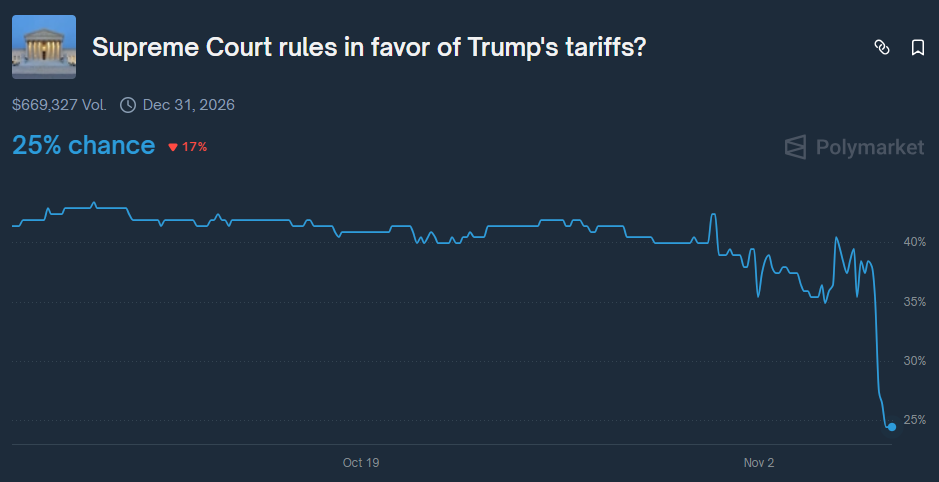
The US government has collected $151 billion from customs duties in the second half of 2025 alone, a nearly 300% increase over the same period in 2024.
Should the court rule against the tariffs, potential refunds could reach approximately $100 billion.
The court has not indicated a date on which it will issue its final ruling, though the Trump administration has requested an expedited decision.
Shutdown Becomes Longest in US History
The US government shutdown entered its 36th day today, officially becoming the longest in history. It surpasses the previous 35-day record set during Trump's first term from December 2018 to January 2019.
The Senate has failed 14 times to advance spending legislation, falling short of the 60-vote supermajority by five votes in the most recent vote.
So far, approximately 670,000 federal employees have been furloughed, and 730,000 are currently working without pay. Over 1.3 million active-duty military personnel and 750,000 National Guard and reserve personnel are also working unpaid.
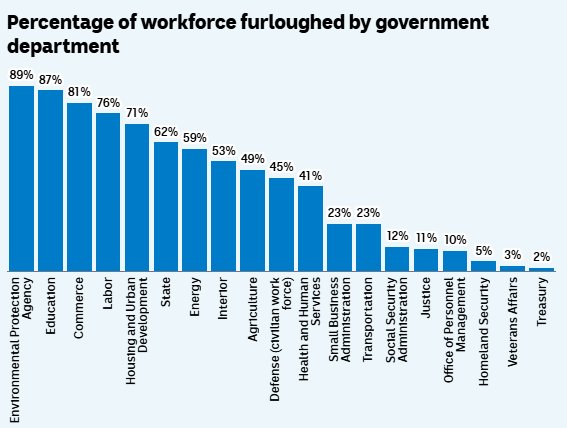
SNAP food stamp benefits ran out of funding on November 1 — something 42 million Americans rely on weekly. However, the Trump administration has committed to partial payments to subsidise the benefits, though delivery could take several weeks.
Flight disruptions have affected 3.2 million passengers, with staffing shortages hitting more than half of the nation's 30 major airports. Nearly 80% of New York's air traffic controllers are absent.
From a market perspective, each week of shutdown reduces GDP by approximately 0.1%. The Congressional Budget Office estimates the total cost of the shutdown will be between $7 billion and $14 billion, with the higher figure assuming an eight-week duration.
Consumer spending could drop by $30 billion if the eight-week duration is reached, according to White House economists, with potential GDP impacts of up to 2 percentage points total.


You've been using a 30-pip trailing stop for as long as you can remember. It feels professional, manageable and relatively safe.
But during volatile sessions, you see your winners get stopped out prematurely, while low-volatility winners drift back and hit stops that are relatively too tight.
Same 30 pips, different market contexts, but inconsistent in the protection of profit and overall results.
The Fixed-Pip Fallacy?
Traders gravitate toward fixed pip trailing stops because they feel concrete and calculable. The approach is easy to execute, readily automated through platforms like MetaTrader, and aligns with how most people naturally think about profit and loss.
But this simplicity masks a fundamental problem.
A twenty-five pip move in EURUSD during the London open represents an entirely different market event than the same move during the Asian session. The context matters, yet the fixed-pip approach treats them identically.
This becomes even more problematic when you consider different currency pairs. GBPJPY might have an average true range of thirty pips on an hourly chart, while EURGBP shows only ten. The same trailing stop applied to both instruments ignores the reality that volatility varies dramatically across pairs.
Timeframe introduces yet another layer of complexity. Take AUDUSD as an example: a ten-pip move on a four-hour chart barely registers as meaningful price action, but on a five-minute chart it represents a significant swing. The fixed-pip method treats these scenarios as equivalent.
The natural response might be to use something more sophisticated, like an ATR multiple. This accounts for your chosen timeframe, the instrument's normal volatility, and even session differences. But it brings its own complications.
When do you measure the ATR? Do you use the value at entry, knowing it might be distorted by sessional effects? Or do you make it dynamic, which becomes far more complex to implement in practice?
Perhaps there's another way forward that doesn't rely on abstract measures of volatility but instead responds directly to the movement of price in relation to the trade you're actually in—accounting for your lot size and the profit you've already captured.
Maximum Give Back: The Percentage Approach
Instead of asking "how do I protect profit after fifty pips," ask "how do I protect profit after giving back a certain percentage of open gains."
Consider a maximum give-back threshold of 40%. When your trade is up one hundred pips, the trailing stop activates if price retraces forty pips from peak, locking in a minimum of sixty pips.
But when that same trade reaches two hundred fifty pips of profit, the stop adjusts, and now it activates at a one-hundred-pip pullback, securing at least one hundred fifty pips. The stop distance scales naturally with the magnitude of the win you're sitting on.
This creates a logical asymmetry that fixed pip approaches miss entirely. Small winners receive tighter protection. Big winners get room to breathe.
The approach adapts automatically to what the market is actually giving you in real time, without requiring you to predict anything in advance.
You don't need to maintain a reference table where EURUSD gets thirty pips and GBPJPY gets sixty. You don't need different standards for different instruments at all.
The same 40% logic works whether the average true range is high or low, whether volatility is expanding or contracting. It survives regime changes without requiring recalibration because it's responding to the trade itself rather than to abstract measures of what the instrument normally does.
The market tells you how much it's willing to move in your direction, and you protect that information proportionally. Nothing more complicated than that.
Key Parameters to Specify in Your System:
- Maximum Give Back Percent: 30-50% is typical, but is dependent on how much profit retracement you can tolerate.
- Minimum Profit to Activate: In dollar amount or an ATR multiple form entry. This prevents premature exits on tiny winners, e.g., if it has moved 5 pips at 40% that would mean you are only locking in a 3-pip profit.
- Update Frequency: Potentially every bar. More frequent, but there may be issues if there is a limited ability to look at the market (if using some sort of automation, this could be programmed).
Is Maximum Giveback Always the Optimum Trail?
As with many approaches, results can be highly dependent on underlying market conditions. It is important to be balanced.
The table below summarises some observations when maximum giveback has been used as part of automated exits.
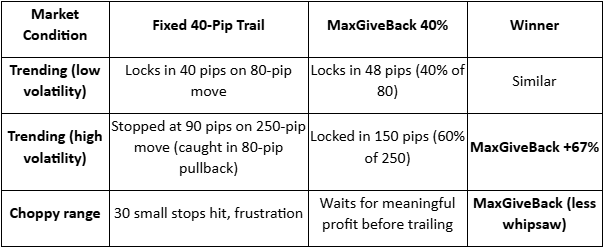
The major difference isn’t likely to be an increased win rate. It is about keeping more of your runners during high-volatility price moves rather than donating them back to the market.
It may not always be the best approach, as different strategies often merit different exit approaches.
There are two obvious scenarios where fixed pips may still be worth consideration.
- Very short-term scalping (sub-20 pip targets)
- News trading, where you want instant hard stops
Integrating Maximum Giveback With Your System
You may have other complementary exit filters in place that you already use. Remember, the ideal is often a combination of exits, with whichever is triggered first.
There is no reason why this approach will not work well with approaches such as set stops, take profits and partial closes (where you simply use maximum Giveback in the remainder as well as time-based exits.
Final Thoughts
To use fixed-pip trailing stops irrespective of instrument pricing, volatility, timeframe, and sessional considerations is the trading equivalent of wearing the same jacket in summer and winter.
Maximum Give Back trailing adjusts to the ‘market weather’. It won't make bad trades good, but it will stop you from cutting your best trades short just because your stop was designed for average conditions.
The market doesn't trade in averages but has specific likely moves dependent on context. Your exits should not be average either.


Multi-Timeframe (MTF) analysis is not just about checking the trend on the daily before trading on the hourly; ideally, it involves examining and aligning context, structure, and timing so that every trade is placed with purpose.
When done correctly, MTF analysis can filter market noise, may help with timing of entry, and assist you in trading with the trending “tide,” not against it.
Why Multi-Timeframe Analysis Matters
Every setup exists within a larger market story, and that story may often define the probability of a successful trade outcome.
Single-timeframe trading leads to the trading equivalent of tunnel vision, where the series of candles in front of you dominate your thinking, even though the broader trend might be shifting.
The most common reason traders may struggle is a false confidence based on a belief they are applying MTF analysis, but in truth, it’s often an ad-hoc, glance, not a structured process.
When signals conflict, doubt creeps in, and traders hesitate, entering too late or exiting too early.
A systematic MTF process restores clarity, allowing you to execute with more conviction and consistency, potentially offering improved trading outcomes and providing some objective evidence as to how well your system is working.
Building Your Timeframe Hierarchy
Like many effective trading approaches, the foundation of a good MTF framework lies in simplicity. The more complex an approach, the less likely it is to be followed fully and the more likely it may impede a potential opportunity.
Three timeframes are usually enough to capture the full picture without cluttering up your chart’s technical picture with enough information to avoid potential contradiction in action.
Each timeframe tells a different part of the story — you want the whole book, not just a single chapter.

Scalpers might work on H1-M15-M5, while longer-term traders might prefer H4-H1-H15.
The key is consistency in approach to build a critical mass of trades that can provide evidence for evaluation.
When all three timeframes align, the probability of at least an initial move in your desired direction may increase.
An MTF breakout will attract traders whose preference for primary timeframe may be M15 AND hourly, AND 4-hourly, so increasing potential momentum in the move simply because more traders are looking at the same breakout than if it occurred on a single timeframe only.
Applying MTF Analysis
A robust system is built on clear, unambiguous statements within your trading plan.
Ideally, you should define what each timeframe contributes to your decision-making process:
- Trend confirmed
- Structure validated
- Entry trigger aligned
- Risk parameters clear
When you enter on a lower timeframe, you are gaining some conviction from the higher one. Use the lower timeframe for fine-tuning and risk control, but if the higher timeframe flips direction, your bias must flip too.
Your original trading idea can be questioned and a decision made accordingly as to whether it is a good decision to stay in the trade or, as a minimum action, trail a stop loss to lock in any gains made to date.
Putting MTF into Action
So, if the goal is to embed MTF logic into your trade decisions, some step-by-step guidance may be useful on how to make this happen
1. Define Your Timeframe Stack
Decide which three timeframes form your trading style-aligned approach.
The key here is that as a starting point, you must “plant your flag” in one set, stick to it and measure to see how well or otherwise it works.
Through doing this, you can refine based on evidence in the future.
One tip I have heard some traders suggest is that the middle timeframe should be at least two times your primary timeframe, and the slowest timeframe at least four times.
2. Build and Use a Checklist
Codify your MTF logic into a repeatable routine of questions to ask, particularly in the early stages of implementing this as you develop your new habit.
Your checklist might include:
- Is the higher-timeframe trend aligned?
- Is the structure supportive?
- Do I have a valid trigger?
- Is risk clearly defined?
This turns MTF from a concept into a practical set of steps that are clear and easy to action.
3. Consider Integrating MTF Into Open Trade Management
MTF isn’t just for entries; it can also be used as part of your exit decision-making.
If your higher timeframe begins showing early signs of reversal, that’s a prompt to exit altogether, scale out through a partial close or tighten stops.
By managing trades through the same multi-timeframe approach that you used to enter, you maintain logical consistency across the entire lifecycle of the trade.
Final Action
Start small. Choose one instrument, one timeframe set, and one strategy to apply it to.
Observe the clarity it adds to your decisions and outcomes. Once you see a positive impact, you have evidence that it may be worth rolling out across other trading strategies you use in your portfolio.
Final Thought
Multi-Timeframe Analysis is not a trading strategy on its own. It is a worthwhile consideration in ALL strategies.
It offers a wider lens through which you see the market’s true structure and potential strength of conviction.
Through aligning context, structure, and execution, you move from chasing an individual group of candles to trading with a more robust support for a decision.


Major companies have announced over 25,000 layoffs in the U.S. this month alone, with Amazon leading the charge with 14,000 announced corporate job cuts.
This number may increase to 30,000 for Amazon by the end of the year, as CEO Andy Jassy pursues a vision of operating like "the world's biggest startup.”
Other big corporations have followed the same trend, with Target making 1,800 corporate cuts, Starbucks 2,000 positions, and, in Europe, Nestlé plans for over 20,000 cuts.
What distinguishes this round of layoffs is the focus on white-collar roles seen as vulnerable to AI-driven automation—affecting middle managers, analysts, and corporate staff.
Gartner analysts predict that by 2026, one in five organizations will use AI to eliminate at least half of their management layers.
According to a KPMG survey, 78% of executives face intense pressure from boards and investors to prove AI is saving money and boosting profits, with traditional metrics often failing to capture its business impact.

Ford CEO Jim Farley warned that AI will "replace literally half of all white-collar workers," while Salesforce's Marc Benioff claims AI is already doing up to 50% of his company's workload.
Anthropic CEO Dario Amodei predicts AI could eliminate half of all entry-level white-collar jobs within five years, potentially spiking unemployment to 10-20%.
Nvidia Makes History Again As First $5 Trillion Company
NVDA hit a $5 trillion market on October 29, becoming the first company in history to reach this milestone. The achievement came just three months after breaching $4 trillion, further cementing its position as the dominant force in artificial intelligence infrastructure.
Since Q4 2022 — when Chat-GPT launched and began the AI-boom — Nvidia shares have climbed by over 1200% and Nvidia's valuation now exceeds the entire cryptocurrency market and equals roughly half the size of Europe's benchmark Stoxx 600 index.
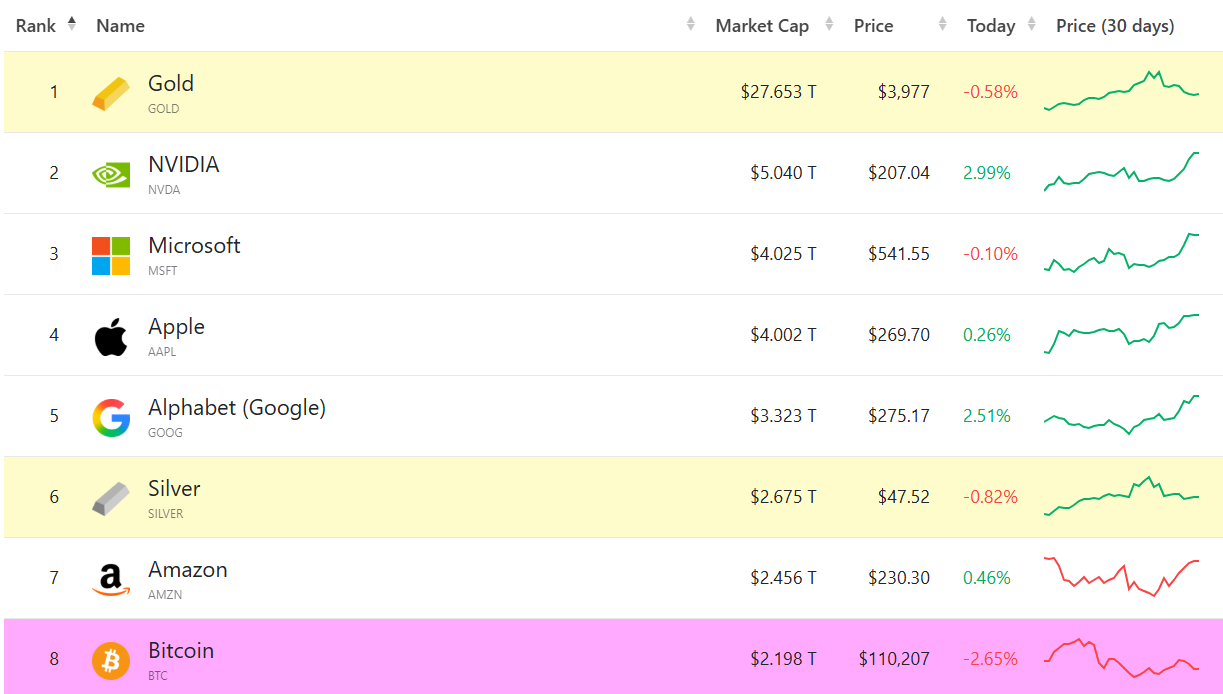
The milestone comes on the back of CEO Jensen Huang unveiling $500 billion in AI chip orders and plans to build seven supercomputers for the US government.
However, there are warnings that AI's current expansion relies on a few dominant players financing each other's capacity, and valuations may be running hot. The real test comes on November 19 when Nvidia reports its quarterly results.
Fed Lowers Rates, but May Be Last Cut of 2025
The Federal Reserve delivered a quarter-point rate cut last night, but Jerome Powell's post-meeting press conference sent a clear message: don't expect another cut anytime soon.
While the Fed moved forward with the expected reduction, Powell pointed to two key obstacles that may prevent further easing this year. First, the ongoing federal government shutdown has created a data blackout, depriving policymakers of critical employment and inflation reports.
Second, Powell revealed "strongly differing views" among Fed officials about the path forward, with a "growing chorus" advocating for a pause before cutting rates again.
Markets responded by adjusting expectations, now pricing in roughly two-to-one odds for a December rate cut — down from what had been considered more certain just hours earlier.
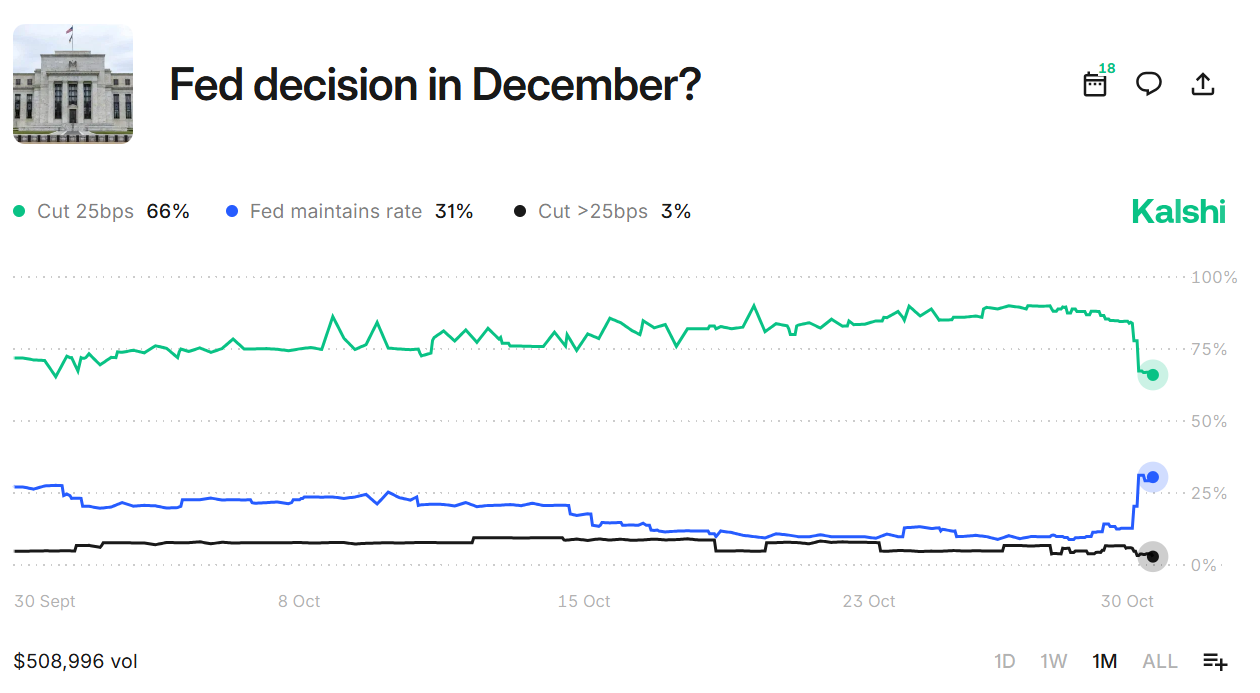
While the Fed still seems to remain committed to eventual rate cuts, the timeline has become dependent on the government shutdown and clearer economic signals about inflation and employment trends.
%20(1)%20(1).jpg)

President Trump and President Xi have scheduled talks for later this week in South Korea, marking their first face-to-face meeting since Trump's return to office. After two weeks of heightened tension, a preliminary framework was established that effectively takes the threatened 100% tariffs off the table.
Treasury Secretary Scott Bessent characterised the framework agreement as being "very successful." This diplomatic progress has created some optimism across markets that the world's two largest economies can avoid the deeper trade conflict that was threatening to destabilise supply chains and accelerate inflation.
Copper Tests Key Resistance
Following a dramatic Q3 that saw prices surge to a record high of $5.81 in July, before plummeting to $4.37 by early August, copper has been steadily recovering as supply fundamentals reassert themselves.
Since breaking through $5.00 in early October, prices have continued to gain strength, rising to $5.11 on October 9. Today's gap higher on trade talk optimism pushed prices back to this key technical level that has proven resistant since March.
A confirmed breakout above $5.24 could open the door to $5.50 and potentially higher, making copper worth watching closely this week as both supply constraints and improving US-China trade relations provide potential tailwinds.
Fed Rate Decision This Week
The Federal Reserve will meet this Wednesday for the October 28-29 policy meeting, with a quarter-point rate cut seemingly fully priced in by markets. Market pricing indicates a 100% probability of an October cut and an 88% chance of another reduction in December.
The key moment will come after the meeting during Fed Chair Powell's press conference — particularly on what he has to say about future rate policy and how the Fed views the balance of risks between inflation and employment.
Market Insights
Watch the latest video from Mike Smith for the week ahead in markets.
Key economic events
Stay up to date with the key economic events for the week.



You have just identified a breakout above $50 resistance that historically wins 65% of the time — with a degree of confidence, you decide to take the trade.
Minutes later, the market starts to stall. Volume fades, price begins to hesitate, and eventually, your stop loss is hit, leaving you to wonder why your “65% setup” didn’t work.
The root cause of what happened is not your setup, but rather the fact that you assume that the probability of a specific trade outcome stays constant after entry.
This assumption locks you into a “static probability trap.”
There is a tendency to treat probability as frozen in time after entering a trade, when in practice it shifts continuously throughout the life of a trade as new evidence enters the market.
Even if this new evidence may not be particularly dramatic, it can still have profound implications for the likelihood of a continuation of current sentiment and price action.
Unconditional Probability: Your Pre-trade State.
What you can rely on as part of your pre-entry decision-making is unconditional probability.
This is your measured historical performance of a setup under similar conditions. It is your expected win rate and previous evidence of hitting a take-profit level.
The pre-trade belief that “This pattern works 60% of the time” is a backward-looking statement, and although based on some evidence, it shapes your belief about how this type of setup behaves on average.
However, as soon as you enter, the truth is that you are no longer dealing with a statistical average, but with this specific trade, unfolding before your eyes in this market environment, right now.
Conditional Probability: After You Enter
Once in the trade, your question becomes “Given what’s happening now with current price movement, volume, time, and volatility, what’s the probability of success?”
This live review of your pre-trade expectation is the conditional probability — your new probability estimate conditioned on the actual market response that is unfolding.
Each new candle, volume shift, or volatility change is new information, irrespective of the underlying cause, and information changes probability.
You are looking to see if:
- Trading volume is confirming or rejecting your entry expectations.
- If “time in the trade” supports further price moves in your favour or decay in market enthusiasm, evidenced in a drop in momentum.
- There are volatility changes that may be indicative of market sentiment accelerating or rejecting the initial move.
This is all about you recognising that some of these changes may result in adverse price moves. Having timely interventions that aim to protect capital and not donate much of your profit back to the market.
Emotional Resistance to Conditional Probability Thinking
As with many trading situations, there is a psychological component of decision-making that can get in the way.
Emotional “demons” that may influence this may briefly include the following:
- Anchoring: “I have done my analysis — it should work.”
- Sunk-Cost Bias: “I’m already in, I might as well wait and see what happens next.”
- Ego: Some may view that exiting means admitting they were wrong.
- Lack of knowledge: “I don’t know how to update probabilities or take appropriate actions.”
- FOMO (fear of missing out): “What if I exit and then runs in my favour?”
These biases keep traders fixed at entry from mental, emotional, and statistical perspectives.
Updating Probability in Real Time
When you boil it all down into absolute core principles, three critical factors dominate the “in the trade” probability landscape after trade entry.
1. Trading Volume — Conviction or Rejection
Volume is the purest signal of conviction. It shows the strength behind the move and how much belief the market has in your trade direction.
- High volume in your direction = strong confirmation; probability rises.
- Fading or below-average volume = weak conviction; probability erodes.
- High volume against you = rejection; probability collapses.
You can think of volume as your real-time market feedback gauge. It is the purest real-time evidence, in combination with price, of what other traders are thinking.
When price and volume disagree, this is a signal that the odds may (or already have) changed.
2. Time Elapsed — Pattern Decay
Every trade setup has a shelf life. A breakout that has not moved after a few candles can become statistically weaker than one that fired almost immediately.
The potential scenarios are:
- Quick follow-through: expected behaviour; your entry probability is likely to be intact.
- Extended stagnation: increasing probability decay due to trades losing confidence in the trade direction
- Delayed reversal: final evidence of pattern failure.
Each candle that passes without confirmation can be viewed as a ‘vote’ against your trade from the market.
This dissuades further trading interest in your desired direction, as opposed to when a market is enthused and buying seems to create ever-increasing interest as those who are fearful of missing out jump on board.
3. Volatility Regime — The Environment Shift
Volatility defines your market environment, and this environment can change fast.
- Volatility expansion in your favour confirms momentum; the probability of desirable and expected outcomes increases.
- Volatility expansion against you suggests a potential structural shift in the market, resulting in a fast drop in probability.
- Volatility contraction suggests market consolidation or exhaustion. This may be seen as a flattening of price action and a move from strongly directional to a more neutral price move.
Volatility regime shifts are a potential market indication that “the game when you entered is no longer the same.”
Putting It All into Practice: Your End-of-Candle Review
Managing conditional probability doesn’t mean reacting to every tick. It is formalising a systemised reassessment at defined intervals, often doing an “End-of-Candle Review”, on your chosen trading timeframe as a start point.
At the close of each bar on your trading timeframe, you need to pause and ask the following key questions:
- Has price behaved as expected?
- Yes → maintain or increase confidence.
- No → reduce exposure or prepare to exit.
- Is volume confirming or fading?
- Rising with direction → edge intact.
- Falling or reversing → edge weakening.
- Is volatility expanding or contracting?
- Expanding in your favour → stay the course.
- Contracting or reversing → reassess.
- Has too much time passed without progress?
- Yes → probability decay in play; consider exiting or scaling out.
- What’s the appropriate action?
- Hold, reduce, tighten, or exit — but always act in alignment with the evidence.
This simple routine keeps your decision-making informed by data, adaptable to market change, and unemotional.
None of the above is particularly ‘rocket science,’ but as with most things in your trading, it will require some work at the front end.
Measure the “what if” scenario against previous trades and comparatively measure your old way versus your new system over time to allow for confirmation of this as an approach, but also to allow refinement based on evidence.
Final thoughts
The probability of a trading outcome in a single trade is never static. It evolves with every candle, every shift in volume, and every minute of market time as new information is released.
It does require a mindset shift. As traders, we need to move from the standard “It’s a 65% setup, so I’ll hold.” To an approach that adopts the approach of “It was a 65% setup on entry, but what is the market evidence suggesting now?”
You are reacting to evolving information, and effective probability management becomes something beyond having one good trade (or avoiding a bad one) that compounds small improvement over hundreds of trades into measurable performance.


New U.S. Sanctions on Russia as Putin Conducts Nuclear Tests
The U.S. has imposed new sanctions on Russia's two largest oil companies, Rosneft and Lukoil, after planned peace talks between Trump and Putin collapsed on Wednesday.
Oil prices spiked 3% after the announcement, with Brent crude hitting $64 per barrel.
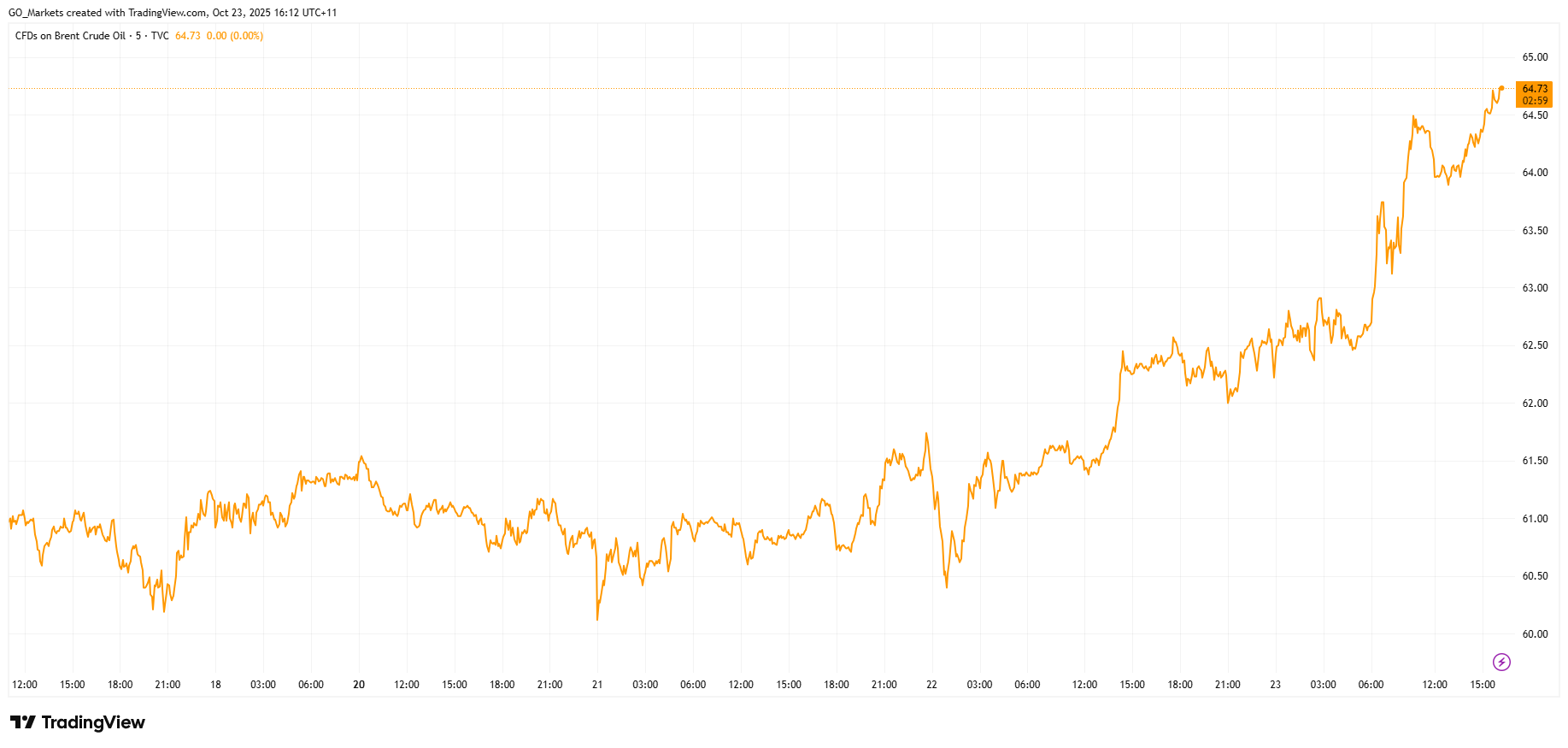
The targeted companies are among the world's largest energy exporters, collectively shipping about three million barrels of oil daily and accounting for nearly half of Russian production.
The sanctions build on recent European measures, as the UK targeted the same companies last week and the EU approved its own sanctions package on Wednesday.
In a show of force coinciding with the new sanctions, Putin supervised strategic nuclear exercises on Wednesday involving intercontinental ballistic missile launches from land and submarine platforms.
While the Kremlin emphasised these were routine drills, the highly coincidental timing is notable.
For markets, the key question now is whether secondary sanctions will follow, and if Trump’s enforcement remains strict. Traders will watch closely for any TACO signals that see Trump ease pressure in an attempt to restart negotiations.
Historic PM Wasting No Time on Celebrations
Sanae Takaichi made history this week as Japan's first female Prime Minister. The 64-year-old conservative leader, dubbed the "Iron Lady,” is already rolling out an aggressive policy agenda that could reshape Japan's economic and geopolitical position.
Her first major move is an economic stimulus package expected to exceed US $92 billion. The package includes abolishing the provisional gasoline tax and raising the tax-free income threshold from ¥1.03 million ($6,800), moves designed to put more money in consumers' pockets and battle inflation.
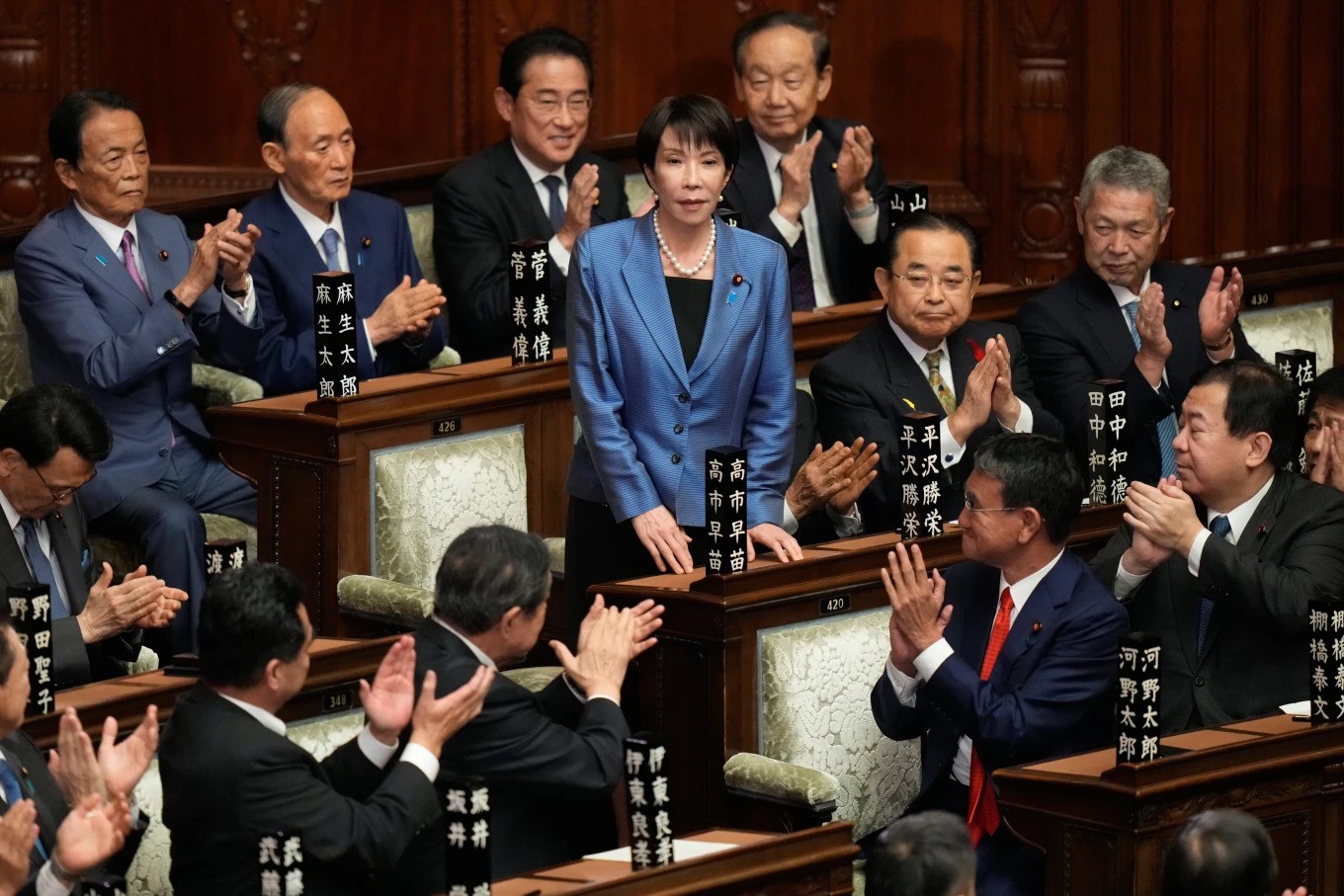
Her next move will come when Trump arrives in Tokyo next week, as the Japanese government is finalising a purchase package including Ford F-150 pickup trucks, US soybeans, and liquefied natural gas as sweeteners for trade talks.
Takaichi has campaigned on being a champion for expansionary fiscal policy, monetary easing, and heavy government investment in strategic sectors, including AI, semiconductors, biotechnology, and defence.
Critical Workers to Miss First Paycheck Due to Shutdown
The U.S. government shutdown is on the verge of creating a crisis for aviation safety, with 60,000 workers set to miss their first full paycheck this week.
These essential workers, who earn an average of $40,000 annually, already saw shortened paychecks last week. By Thursday, many will receive pay stubs showing zero compensation for the coming period, forcing impossible choices between basic necessities and reporting to work.
During the last extended shutdown, TSA sick-call rates tripled by Day 31, causing major delays at checkpoints and reduced air traffic in major hubs like New York — disruptions which are directly attributed to pressuring the end of the previous shutdown.
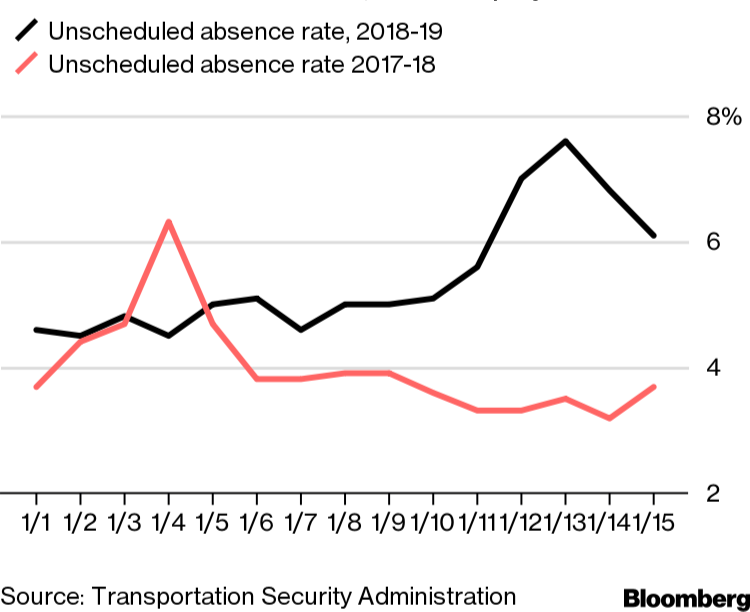
The National Air Traffic Controllers Association warns that similar pressures are building, with many workers soon to be facing a decision between attending their shift or putting food on the table.

